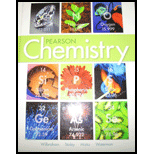
(a)
Interpretation: To calculate the boiling point elevation for the given aqueous solution.
Concept Introduction: The magnitude of the boiling point elevation is in direct relation to the molal concentration. It can be expressed as follows:
This can also be expressed as follows:
Where
(a)
Answer to Problem 119A
The boiling point elevation for
Explanation of Solution
The given aqueous solution is
Each formula unit of
The molal boiling point elevation for water is
Substitute
Thus, the boiling point elevation for
(b)
Interpretation: To calculate the boiling point elevation for the given aqueous solution.
Concept Introduction: The magnitude of the boiling point elevation is in direct relation to the molal concentration. It can be expressed as follows:
This can also be expressed as follows:
Where
(b)
Answer to Problem 119A
The boiling point elevation for
Explanation of Solution
The given aqueous solution is
Each formula unit of
The molal boiling point elevation for water is
Substitute
Thus, the boiling point elevation for
(c)
Interpretation: To calculate the boiling point elevation for the given aqueous solution.
Concept Introduction: The magnitude of the boiling point elevation is in direct relation to the molal concentration. It can be expressed as follows:
This can also be expressed as follows:
Where
(c)
Answer to Problem 119A
The boiling point elevation for
Explanation of Solution
The given aqueous solution is
Each formula unit of
The molal boiling point elevation for water is
Substitute
Thus, the boiling point elevation for
(d)
Interpretation: To calculate the boiling point elevation for the given aqueous solution.
Concept Introduction: The magnitude of the boiling point elevation is in direct relation to the molal concentration. It can be expressed as follows:
This can also be expressed as follows:
Where
(d)
Answer to Problem 119A
The boiling point elevation for
Explanation of Solution
The given aqueous solution is
Each formula unit of
The molal boiling point elevation for water is
Substitute
Thus, the boiling point elevation for
Chapter 24 Solutions
Chemistry 2012 Student Edition (hard Cover) Grade 11
- 14. Calculate the concentrations of Ag+, Ag(S2O3), and Ag(S2O3)23- in a solution prepared by mixing 150.0 mL of 1.00×10-3 M AgNO3 with 200.0 mL of 5.00 M Na2S2O3 Ag+ + S20 Ag(S203)¯ K₁ = 7.4 × 108 Ag(S203)¯ + S20¯ = Ag(S203) K₂ = 3.9 x 104arrow_forwardΗΝ, cyclohexanone pH 4-5 Draw Enamine I I CH3CH2Br THF, reflux H3O+ I Drawing Draw Iminium Ionarrow_forward:0: :0: Select to Add Arrows :0: (CH3)2NH :0: ■ Select to Add Arrows :0: :0: (CH3)2NH ■ Select to Add Arrowsarrow_forward
- Draw the product of the following H action sequence. Ignore any inorganic byproducts formed. 1. (CH3CH2)2CuLi, THF 2. CH3Br Q Atoms, Bonds and Rings H Charges ㅁarrow_forwardPlease help me with this the problem is so confusingarrow_forward14 Question (1 point) Disiamylborane adds to a triple bond to give an alkenylborane. Upon oxidation with OH, H2O2, the alkenylborane will form an enol that tautomerizes to an aldehyde. In the first box below, draw the mechanism arrows for the reaction of disiamylborane with the alkyne, and in the last box draw the structure of the aldehyde. 4th attempt Feedback i > 3rd attempt OH, H2O2 i See Periodic Table See Hintarrow_forward
- answer with mechanisms and steps. handwritten please!arrow_forwardHello I need some help with Smartwork. For drawing structure B, I know the correct answer is CH₃B₂, but when I try to type it in, it keeps giving me CH₄BH₃ instead. Do you know how I should write it properly? Should I use a bond or something else?arrow_forwardTrue or false, chemistryarrow_forward
- answer thse questions with mechanisms and steps. handwritten please!arrow_forwardC app.aktiv.com Draw the product of the following reaction sequence. Ignore any inorganic byproducts formed. H O 1. (CH3CH2)2CuLi, THF 2. CH3Br Drawingarrow_forwardDraw the product of the following reaction sequence. Ignore any inorganic byproducts formed. H O 1. (CH3CH2)2CuLi, THF 2. CHзBr Drawingarrow_forward
 ChemistryChemistryISBN:9781305957404Author:Steven S. Zumdahl, Susan A. Zumdahl, Donald J. DeCostePublisher:Cengage Learning
ChemistryChemistryISBN:9781305957404Author:Steven S. Zumdahl, Susan A. Zumdahl, Donald J. DeCostePublisher:Cengage Learning ChemistryChemistryISBN:9781259911156Author:Raymond Chang Dr., Jason Overby ProfessorPublisher:McGraw-Hill Education
ChemistryChemistryISBN:9781259911156Author:Raymond Chang Dr., Jason Overby ProfessorPublisher:McGraw-Hill Education Principles of Instrumental AnalysisChemistryISBN:9781305577213Author:Douglas A. Skoog, F. James Holler, Stanley R. CrouchPublisher:Cengage Learning
Principles of Instrumental AnalysisChemistryISBN:9781305577213Author:Douglas A. Skoog, F. James Holler, Stanley R. CrouchPublisher:Cengage Learning Organic ChemistryChemistryISBN:9780078021558Author:Janice Gorzynski Smith Dr.Publisher:McGraw-Hill Education
Organic ChemistryChemistryISBN:9780078021558Author:Janice Gorzynski Smith Dr.Publisher:McGraw-Hill Education Chemistry: Principles and ReactionsChemistryISBN:9781305079373Author:William L. Masterton, Cecile N. HurleyPublisher:Cengage Learning
Chemistry: Principles and ReactionsChemistryISBN:9781305079373Author:William L. Masterton, Cecile N. HurleyPublisher:Cengage Learning Elementary Principles of Chemical Processes, Bind...ChemistryISBN:9781118431221Author:Richard M. Felder, Ronald W. Rousseau, Lisa G. BullardPublisher:WILEY
Elementary Principles of Chemical Processes, Bind...ChemistryISBN:9781118431221Author:Richard M. Felder, Ronald W. Rousseau, Lisa G. BullardPublisher:WILEY





